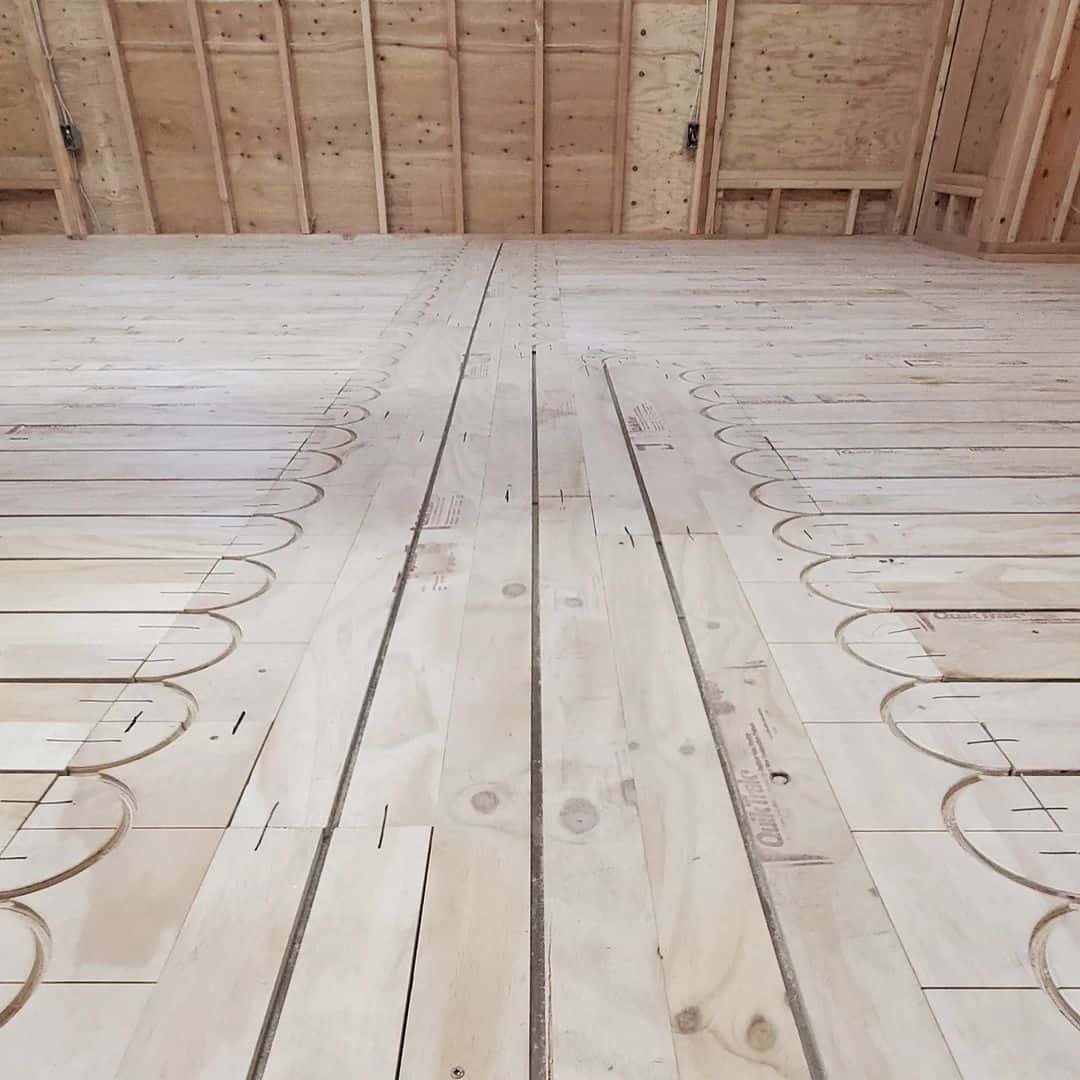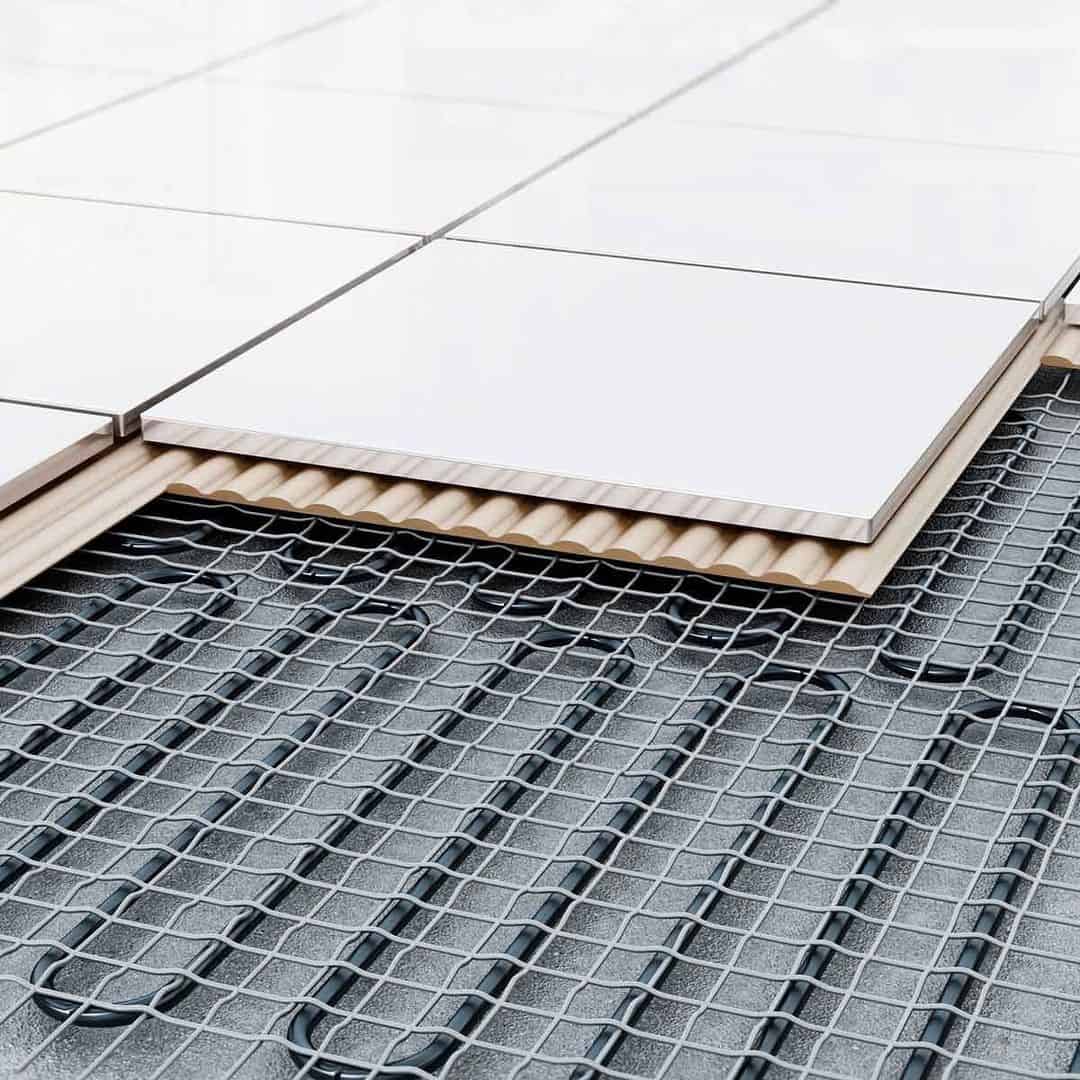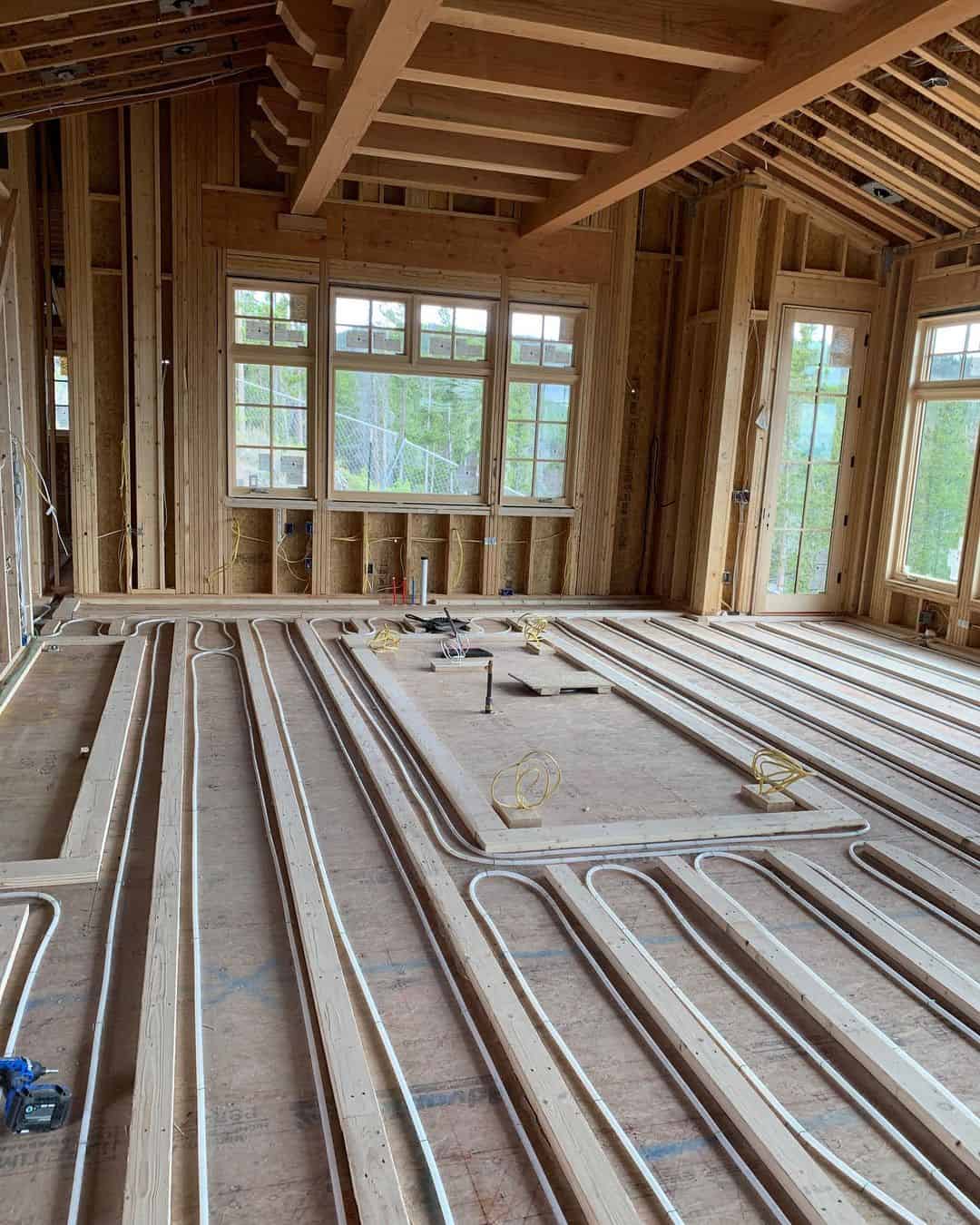Have you ever stepped out of the shower onto an icy cold tile floor or wished your home had a constantly comfortable temperature all year round? With radiant floor heating, these wishes can become a reality. Radiant floor heating is a luxurious and efficient way to heat your home, offering evenly-dispersed warmth from the ground up.
This article will explore what precisely radiant floor heating is, how it works, and its many benefits for homeowners.
Table of Contents
What is Radiant Floor Heating?
It is a home heating system that uses radiant energy to warm the floors and objects in a room. This energy is produced by hot water tubes, electric wires, or air-heated systems installed beneath the floor.
These systems are often referred to as “radiant heat” as they directly transfer warmth. In comparison, forced-air heating systems rely on convection currents that often leave certain areas of a room feeling cold or drafty.
Radiant floor heating is an energy-efficient way to create a comfortable environment in your home. It can be used as the primary or supplemental source of heat, and it’s capable of providing uniform warmth throughout the entire house.
Types of Radiant Floor Heating
Radiant floor heating works by circulating hot water through special tubing or electrical cables positioned beneath the floor. PEX (cross-linked polyethylene) and PERT (polyethylene of raised temperature resistance) tubing can be used in hydronic systems, while electric radiant floors require a network of electric wires embedded into the subfloor.
1. Air-Heated Radiant Floor Heating Systems
Air-heated systems are not standard, but they can be an option for off-grid living. These systems use forced air to heat the floors rather than hot water or electricity.
Considering the lack of heat retention, this type of floor heating is not cost-effective for residential applications. Air-heated radiant floor heating systems are usually combined with solar air heating systems, which provide heat only during the day.
This system is not recommended as it does not provide reliable heating at night when most homes need the most heat. Air-heated systems require a significant amount of space and are usually only used in garages and workshops. Despite their inefficiencies, they are a viable option for those looking to reduce their energy consumption.
2. Hydronic Radiant Floor Heating Systems
In hydronic systems, a boiler is used to heat the water and pump it through tubing beneath the floor. Once the hot water reaches the designated area, it radiates energy into the floors and objects in the room. The warm water continues to circulate until it reaches its selected temperature, at which point a thermostat will shut off the flow. The water is then returned to the system, which can be reheated and reused.
This type of radiant floor heating can be installed in various ways, including embedded in concrete slabs, over an existing slab in cement, nailed under the subfloor, or fitted into specially designed channels. The heated floors are ideal for any type of finished floorings, such as vinyl, hardwood strip flooring, carpet, or tile, and can reduce allergens and dust in the home.
In areas of high humidity, engineered wood flooring may be recommended, as changes in moisture content can cause warping and cracking in solid wood floors. However, hydronic radiant floor heating can also be used as supplemental heat to warm a space faster than conventional systems. The temperatures are easily adjustable, and the system runs quietly without any sensitive components or ducts.
3. Electric Radiant Floor Heating Systems

Electric radiant floors use wires embedded in a mat and placed beneath the finished floor surface. These systems have become increasingly popular due to their ease of installation and energy efficiency, allowing homeowners to warm small areas such as bathrooms or kitchens without installing an entire hydronic system.
Electric radiant heat is measured in watts per square foot and is ideal for heating small areas. Typically, the mats can be set to different temperatures controlled by a thermostat. It’s essential to factor in any existing insulation when installing electric radiant floors, as it can help reduce energy costs and increase comfort levels.
Hydronic vs. Electric Radiant Floor Heating: Which is Better?
The answer to this question comes down to your budget, the area you need to cover, and what kind of installation process you’d prefer.
1. Installation
Electric radiant floor systems are the easier of the two when it comes to installation. They require less up-front work as they can be installed directly onto a subfloor and do not require any additional plumbing or wiring.
Hydronic systems are more complex in their installation process since they must be connected to a boiler, heat pump, water heater, and/or other components.
2. Cost
Electric radiant floors are less expensive up-front since they require fewer resources and labor to install. Hydronic systems require more cost and installation time but may save you money due to their efficient energy use.
3. Heat Output
Electric radiant floors produce a limited amount of heat depending on the square footage of the area, while hydronic systems can provide more consistent heat throughout larger areas.
This makes electric systems better suited for smaller areas and hydronic systems better for large-scale heating needs such as whole-house heating.
4. Maintenance
Electrical floor heating requires little to no maintenance and can last for many years. They are also easy to repair if something goes wrong. Hydronic radiant floor systems require more maintenance, as the system must be periodically checked for leaks and other issues.
The boiler needs regular preventative maintenance, such as filter changing and cleaning, and the water within the pipes should be flushed yearly to remove any sediment buildup. If a leak occurs, you must address it immediately, as it can lead to water damage and other costly repairs.
Hydronic systems must be monitored and adjusted regularly to maintain optimal temperatures.
5. Floor Covering Options
Electric radiant floor heating is suitable for all floor coverings, from carpets to vinyl, laminate, and even ceramics. Hydronic systems require a specific floor covering compatible with the system’s heat output.
Advantages of Radiant Floor Heating

Radiant floor heating has a lot of advantages, especially when it comes to comfort and efficiency. But as with any home improvement project, there are also some potential drawbacks that you should be aware of before making your decision.
1. Uniformly Heats
These types of heating systems provide uniform warmth to the entire space. Since it radiates from the floor, you’ll experience even temperatures throughout your home rather than cold spots in some areas and hot spots in others.
This way, you can enjoy consistent comfort without relying on supplemental heat sources such as electric heaters.
2. Efficiency
Radiant floor heating systems are energy efficient, as the system is designed to heat from the ground up. With traditional forced-air systems, warm air rises and cool air falls; this can cause temperature inconsistencies in different parts of your home.
Radiant heat creates a consistent warmth that eliminates these temperature inconsistencies. Since the heated surfaces are located within your floors and radiate outward, there is less energy wasted than traditional forced-air heating systems, as warm air doesn’t escape through open doorways or windows.
3. No Noise
Radiant floor heating systems are practically silent, providing a comfortable and warm environment without the need for noisy radiators or blowers.
This allows you to enjoy peaceful spaces day and night and avoid being disrupted by loud noises in your home.
4. Healthier Living
Radiant floor heating systems provide a dust-free environment for your home. Traditional forced air systems can blow around dust, dirt, and other allergens, causing respiratory issues or allergies to worsen.
Radiant floor heating systems create an allergen-free space by not blowing around airborne particles, ensuring healthier living in your home.
5. Low Maintenance
No components need to be serviced or replaced; you can enjoy the benefits of this system with minimal ongoing effort.
The system is designed to last for many years; in most cases, you will need to turn it on and forget about it.
The energy savings associated with radiant floor heating are significant, allowing you to save money on your heating bill. When you don’t have to use a lot of fuel for your home’s heating system, you do your part for the environment by reducing air pollution and greenhouse gas emissions.
6. Safety
Radiant floor heating does not have to operate at high temperatures like other heating systems, which can cause burns if touched or come in contact with furniture or other items in the room.
There are no exposed wires or cords, and you don’t have to worry about electrical fires or other hazards.
7. Easy To Install
Radiant floor heating is relatively easy to install. It requires some basic carpentry and plumbing knowledge as well as electrical skills. Most radiant floor heating systems have detailed instructions on properly installing the system.
Professional installation is available if you feel uncomfortable installing it yourself.
Disadvantages of Radiant Floor Heating

1. Installation Costs
Installing radiant floor heating systems can be costly and labor-intensive, as the system must be embedded in the floors of your home—either in the concrete slab or between subfloor layers. This will require professional installation, which can add significantly to the overall cost.
2. You Need to Replace the Flooring
Depending on the type of flooring in your home, you need to replace certain materials to accommodate radiant floor heating. Tile is the most popular material for radiant floor heating as it conducts heat well. There are other options available such as wood, laminate, and vinyl.
If you have hardwood floors, floating hardwood is often recommended, as this can be easily removed and replaced if necessary. It is essential to choose a material that conducts heat efficiently to make the most out of your system.
3. Long Wait Times
Radiant floor heating can take some time to heat up, depending on the size of the area and how cold it is outside.
It may take a few hours for the system to reach its desired temperature, which can be inconvenient if you need immediate warmth. Once the heating has stopped, it can take some time for the area to cool down.
4. Power Requirements
Radiant floor heating systems require a significant amount of power to operate, so you may need to upgrade your electrical system to accommodate a new system.
You should always consult an electrician before installing to ensure that your home is wired correctly and all necessary upgrades have been made.
Maintenance and Efficiency Tips for Radiant Floor Heating
Regular maintenance and upkeep of your radiant floor system are necessary for achieving the most efficient heating possible.
- Insulate your subfloor, walls, and ceilings as much as possible—this will reduce heat losses and improve comfort levels.
- Ensure all exposed pipes and wiring are well insulated to keep your radiant floor system from losing heat.
- Check the thermostat regularly to ensure it works correctly and that your home is heated to the desired temperature.
- Ensure that all radiators, boilers, and pumps function correctly for optimal efficiency.
- Have your hydronic or electric radiant floor heating system inspected and serviced annually to ensure it works perfectly.
- Ensure all carpets, mats, and other floor coverings are not blocking the flow of heat from your floors. This can affect comfort levels in your home.
- If you are installing a floating hardwood floor, leave enough space between the boards for air to circulate freely so that your radiant heating system can operate efficiently.
- For electric radiant floors, properly connect and install all wiring and circuits according to safety regulations.
- Clean your floors regularly to keep dust, dirt, and debris from blocking the heat flow.
Final Thoughts
Radiant floor heating systems are an excellent way to heat your home efficiently and comfortably. By distributing heat evenly and gently, radiant floor heating systems create a cozy atmosphere that can help you save money and energy.
Installing a radiant floor heating system is relatively easy if you research and find the right professional to help you along the way. With all these benefits, it’s easy to see why radiant floor heating is becoming increasingly popular in homes and businesses.
Whether you’re building a new home or just looking for a way to upgrade your existing flooring, a radiant floor heating system can be the perfect solution. So go ahead and invest in this modern heating option; you won’t regret it!